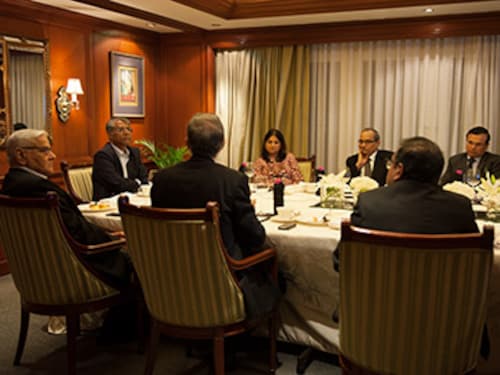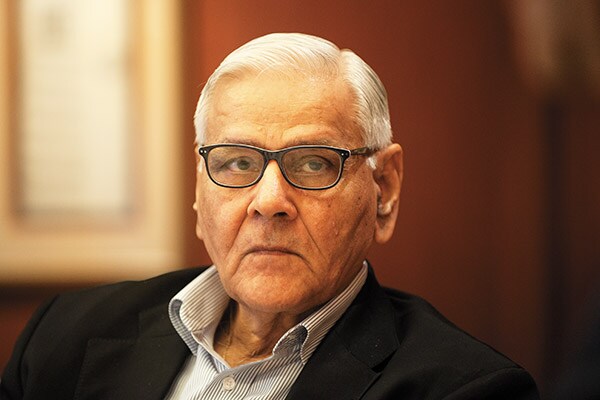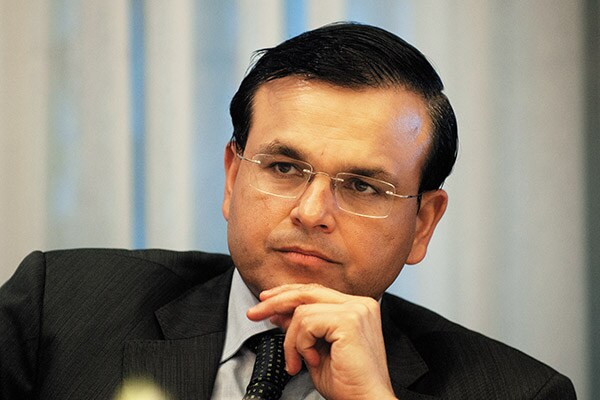'Build infrastructure for quick growth'
Industry leaders want the government to make structural changes in the PPP model to achieve the desired results


Prime Minister Narendra Modi’s vision for an economic turnaround in the country has sprung hope among global investors. However, while big bang reforms are expected, growth will largely depend on infrastructure spends and completion of projects, both stalled and new. The government has expressed its willingness to remove bottlenecks and change the urban landscape of the country with its promise of developing “100 smart cities” and introducing bullet trains. Highways, high-speed networks, mega power plants and port upgrades are on the agenda as well. But this will take time.
India will have to spend $1 trillion on infrastructure by 2017 to help alleviate the sector from creaking. And its experience with public-private partnerships on infrastructure has, thus far, not yielded the desired results. So what needs to be done to improve the financing and execution of infrastructure projects?
As part of the fourth session of the Forbes India CEO Dialogues: The Leadership Agenda, industry leaders shared their views on the steps needed for the revival of infrastructure development in India. Niranjan Hiranandani, founder of Hiranandani Constructions, Jatinder Mehra, director, Essar Steel, Seshagiri Rao MVS, joint managing director, JSW Steel, Archana Hingorani, CEO, IL&FS Private Equity, and Sunil Kaushal, chief executive officer, India & South Asia operations, Standard Chartered, discussed the roadmap for stimulating infrastructure growth in the country. Here are excerpts from the discussion moderated by R Jagannathan, editor-in-chief, . Niranjan Hiranandani
Niranjan Hiranandani
R Jagannathan: Mr Hiranandani, are you bullish on India’s infrastructure outlook?
Niranjan Hiranandani: Narendra Modi has conveyed his aspirations: To build national highways, have bullet trains, improve water availability and provide education. And he is walking the talk by preparing the necessary wherewithal to get things executed. He is trying to replicate the Gujarat model [of developing industry and creating jobs] across India. The question is whether he can do it as fast as he desires. I am pretty bullish about the aspirations he has mentioned our interaction with various ministries indicates that fast, pragmatic steps are being taken to meet these goals.
There is a visible change in attitude towards investment [with Japan willing to fund the Rs 55,000 crore Mumbai-Ahmedabad bullet train project]. Modi’s official trip to the US and Chinese president Xi Jinping’s visit to the Sabarmati riverfront are also key pointers. The PM is marketing India to boost investment and funding. Of course, there would be hiccups along the way, but I believe we would be successful.
Today, brokers [middlemen] in Delhi are not being entertained, nobody is asking for money and the focus is only on execution of projects. There is a change of attitude among bureaucrats too and if that percolates down among the others, we could see a different India very soon.
Jagannathan: Dr Hingorani, give us the bearish view on this.
Archana Hingorani: If you look at previous years, when India really blossomed, it was because everything, including permission and approvals, worked in unison. Investment was always available, but the point was how much money could be utilised. In recent years, every government officer has been questioned on whether he made the right decision on approvals.
No entrepreneur or established corporate can say with guarantee that a government-approved project will be completed by a particular date because various issues crop up every now and then. I am waiting to see how the implementation of infrastructure projects takes place.
Jagannathan: Mr Mehra, do you see any changes on the ground?
Jatinder Mehra: The government is making the right noises and there is positivity everywhere. But the real test will be to see how the projects are implemented. It will depend not just on the government, but also on states and courts, which may have a different view sometimes.
Jagannathan: In terms of infrastructure projects, do you see movement at the state level?
Seshagiri Rao: We are yet to see tangible changes so far. Growth in steel consumption in India was less than a percent last year [India consumed 73.93 million tonnes of steel in 2013-14, a 0.6 percent rise year-on-year]. But our talks with customers about their plans for the coming quarters reveal that everybody is optimistic and planning for growth.
The public-private partnership (PPP) model has not given the desired results as experience across industries suggests. It can work in India, but the structural problems in the PPP model need to be removed in a systematic manner. One step, as the [Union] budget mentioned, could be the introduction of “3P India” [an institution with Rs 500 crore corpus to provide support to PPPs].
Hingorani: But there is one issue. Corporate India has seen sustained high interest rates, beyond 11-12 percent [on infrastructure loans], so it will not be possible for projects across sectors to become viable for a long time. All companies have suffered heavily on that account.
Rao: We have to identify our negatives such as high interest rates and inflation as well as the positives, including low labour costs and mineral resources. We have to find our competitive advantage and use the positives to eradicate the negatives. If we say inflation and interest rates will have to come down for growth to happen, it may not be entirely true. The correlation between the two is not so high, as the previous RBI governor, D Subbarao, used to say. Jatinder Mehra
Jatinder Mehra
Mehra: We also have to look at the quality of infrastructure we have built over the years. Quantitatively, India’s infrastructure since the 1991 liberalisation matches that of China’s 20 years after their liberalisation. But, quality-wise, we fall apart. Our infrastructure quality is poorer than Malaysia, Thailand, Indonesia and China. In recent years, there have hardly been any projects that were completed on time and without cost overruns.
Jagannathan: Mr Hiranandani, what are the roadblocks which are holding people back? What changes are required?
Hiranandani: Since polity is proactive, we need to get the bureaucracy with us. Today, a bureaucrat is given credit for not doing something there needs to be a 180-degree change. We also need technical bureaucrats. There has to be a team of people who are given responsibility for 10-20 years. Transparency in execution and accountability is also required, with targets, both promised and achieved.
We have seen successes in pockets. For instance, in the cleaning up Surat city [after the 1994 plague], in the Anand milk project or in the construction of the Mumbai-Pune Expressway. We are also getting better equipped to handle natural disasters.
Jagannathan: If the PPP model has not worked, what is the way forward?
Hingorani: Privatisation has worked earlier, in telecom. Today, we need to change the PPP model. If it is a true PPP, the government needs to take the onus of all the risks relating to approvals while the corporate must take the responsibility for financial risks. This has not been happening in recent years.
Jagannathan: Mr Hiranandani, there could be a huge push for growth from the real estate sector. Housing is still unaffordable for the masses. Is there something which can be done there?
Hiranandani: In 1991, when we decontrolled several sectors like aviation, we increased control in real estate. Each level of government, including states and local bodies, increased taxation. Today, the tax is 31 percent of the total cost of an affordable house it was 10 percent 20 years ago. We need to make a structural change in terms of taxation. The cost of land has risen beyond imagination. We have not been able to increase the floor area ratio (FAR). But this can be done only through infrastructure growth.
In Mumbai, 55 percent of the population lives in slums. More than half of them can afford the value of the slum they live in. If it was legal, they could have mortgaged and bought it. Politicians think they are helping the poor, but they have destroyed their wealth. We need to deregulate the industry. If we take the right steps, the housing sector can contribute two percent of GDP in 10 years. China took all its surplus unemployment and absorbed it into construction.
Jagannathan: Dr Hingorani, looking at the entire infrastructure sector, which areas are most likely to take off with little interventions?
Hingorani: The road sector needs the least amount of tweaking it is all about implementation, efficiency and getting it going. The power sector is looking for a solution, so it may take time. Ports should have fared handsomely, but we have not seen that many projects: Issues like returns on investments and jobs take time. There is not a single airport in India that has not been refurbished the sector has done well on its own.
Mehra: The government has to showcase roads and the railway sector as they are visible and would set an example. But all the funding must come from the government-allocated budgetary funds. Sunil Kaushal
Sunil Kaushal
Jagannathan: Mr Kaushal, is domestic funding a problem for infrastructure projects?
Kaushal: The government does not have the finances or the balance sheet to fund infrastructure projects because of the populist steps taken by previous governments. Even to balance the current fiscal deficit target of 4.1 percent of GDP, a lot would depend on divestment over the next two years. Till economic growth picks up, the government does not have the elbow room to say it can commit more to infrastructure. We have a huge backlog of port and power projects, which is hurting the balance sheets of corporates. Capital has been invested while the rupee has depreciated they are getting no returns.
Jagannathan: Do you think corporates will spend more time fixing their balance sheets instead of investing in infrastructure?
Mehra: Not many corporates will like to put their money on the ground at present. They would want to see how the business environment changes before they make any investment.
Jagannathan: When do you think India’s infrastructure will pick up and start firing on all cylinders? What is the time frame?
Hiranandani: Some sectors will pick up while others will take time. Road and railways are the quick fixes. The damage has been very severe in some other cases where projects were delayed. But there is sufficient amount in the kitty to see that new infrastructure takes off. I am very bullish more corporates will be willing to take the risk of investing. We could see the infrastructure boom around Diwali 2015.
Mehra: This kind of government should continue for 10-15 years.
Kaushal: It could take 12 months before we see the green shoots. The government has the mandate and we have a leader who wants to leave behind a legacy. But it will take some time.
Rao: I expect it would take two years before big investments come back into India.
Hingorani: I agree with Mr Rao. It could take two years. The vastness of the problems means it could take time.
Hiranandani: This is the final opportunity that India has. If we can’t make things work, we don’t know what will happen two years down the line. But show me one step taken by the government till today which was wrong. There is none.
First Published: Oct 27, 2014, 06:56
Subscribe Now